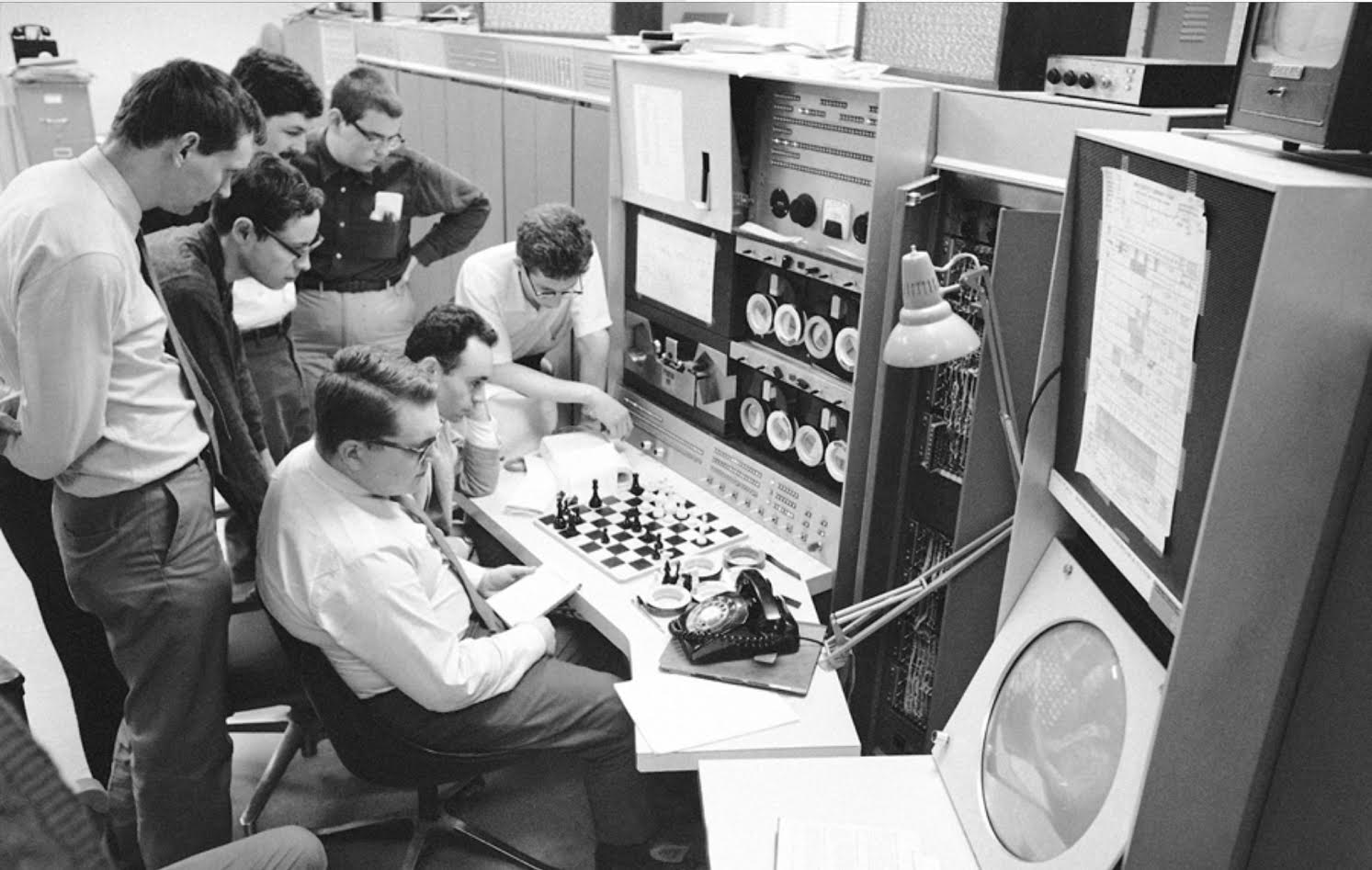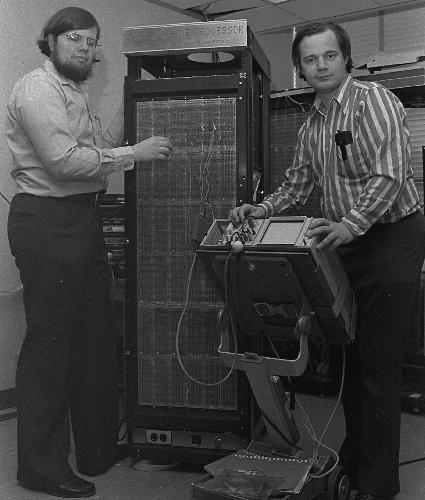On January 21, 1967, a mild winter Saturday in Cambridge, Massachusetts, a couple of computer researchers from the Artificial Intelligence (AI) Laboratory at the Massachusetts Institute of Technology (MIT) flagged down a taxi near Tech Square. Loading a bulky, 60-pound teletype called a 35 KSR (“Keyboard Send/Receive”) into the trunk, they set off for downtown Boston, across the river. A short while later, the cab pulled up at the Young Men’s Christian Union (YMCU), and the researchers wrestled the machine up the stairs to the second floor, where the Boylston Chess Club was setting up for a weekend tournament.
Making intelligence visible
As the teletype was being set up alongside a physical chess board, Stu Nelson, another AI Lab member and skilled phone hacker, tinkered with the YMCU’s phone line to connect the teletype to the Lab’s computer, located a few miles away on the 9th floor of Tech Square. There, a group of researchers gathered around a second physical chess set, arranged in front of a PDP-6, a room-sized computer made by the Digital Equipment Corporation. The PDP-6, released in 1964, was a well-equipped machine with a 256K Fabritek main memory, 4 spinning microtape drives, a DEC 340 graphics display and a paper tape reader, which loaded the program into memory. At the time it played in its first two tournaments, the computer had only a 16K memory, nearly all of which was occupied by the program. Lab members Bill Gosper (pictured below with his hand poised above the board) and Allen Moulton (below, seated, leaning on his hand), operated the PDP-6, while Alan Baisley, proficient at both programing and chess, operated the teletype machine at the tournament site. Listening intently to the machine, monitoring its inputs and outputs, MacHack’s attendants at the tournament put faces and a tangible presence on the invisible performance of thinking and reasoning inside of the computer. They projected a sense that MacHack was not simply an external aid for a human player; it was playing using its algorithms, and humans were observing the results.

Students at MIT’s Artificial Intelligence Lab in Cambridge, watch the computer play chess against a human opponent miles away in downtown Boston. Image courtesy of MIT and The Computer History Museum.
Greenblatt’s Hack
Richard Greenblatt, a former MIT student then working on several initiatives at the Lab, was both a very good chess player and master computer hacker. Greenblatt was the primary author of the program, which was partly supported by Project M.A.C., a far-ranging series of research efforts at MIT sponsored by the Advanced Research Projects Agency (later called DARPA), the Department of Defense, and funding from the Office of Naval Research. Greenblatt co-authored a paper on the project, presented at the Fall Joint Computer Conference in 1967.(1) Greenblatt began writing MacHack VI in MIDAS, a PDP-6 macro assembly language, in mid- November 1966, finding time between his many research projects. His program was entered into the competition as “Robert Q.” It became the first chess program to formally compete against a human opponent in tournament play.

Richard Greenblatt, right, pictured with an oscilloscope, and his colleague Thomas Knight, with the CADR LISP computer they developed at MIT’s AI Lab, c. 1978. Image courtesy of MIT and The Computer History Museum.
At MIT’s AI Lab, there was interest in chess, and in the progress of Greenblatt’s program. MIT students, including 3 who were national chess masters, as well as several MIT faculty, visited the Lab to test MacHack’s progress. An outspoken AI skeptic, philosophy professor Herbert Dreyfus, was invited to come and try his skill against the machine. He dropped by the Lab and lost to the computer. Dreyfus had expressed his belief that a computer could not beat a human, even a child. Greenblatt, who had been playing chess since childhood, later noted dryly that Dreyfus wasn’t a particularly good player.(2)
For the first game of the tournament MacHack VI was matched with an excellent player, Carl Wagner, who was a national master. Wagner, playing white, chose his first move, which the teletype operator duly communicated to the computer at Tech Square. MacHack VI’s response was transmitted back to the terminal, and the MIT teams at each end moved the physical pieces on the boards. Wagner won the first game after 55 moves. MacHack VI played 4 subsequent games that weekend against different opponents. Overall, MacHack VI lost 4 and played to a draw in the 3rd game. The AI Lab members viewed the performance of Greenblatt’s tournament-quality chess program as a significant improvement on previous chess programs, and a step closer to achieving a true thinking machine. Some skeptics were unconvinced or perhaps felt threatened, and one newspaper summarized the event as, “MIT Computer Loses to Human in Chess.”(3)
A program joins the Federation
The Massachusetts State Chess Federation had required the program to join the association in order to enter the competition. On the basis of the first tournament’s results, the Federation would eventually assign the program a rating of around 1200, making it a Class D player—a strong “social player,” though no match for top human chess masters.(4) Greenblatt continued to develop MacHack, which in late April entered another tournament in Boston, eventually achieving a performance rating of 1820, its highest rating during that era. Mackhack’s entry into the arena hinted at a growing ambiguity about who or what could be called a chess player, and a blurring of the human/machine boundary as AI began to advance. MacHack would go on to compete in a series of tournaments, with Greenblatt continuing to improve its performance over time.
Before Greenblatt arrived at MIT, Professor John McCarthy had worked on an early chess program, which MIT student Alan Kotok refined for his masters thesis project. Though they had made some progress, Greenblatt noted that their efforts were only modestly successful, and lacked a deep understanding of the game.(6) McCarthy later decamped for Stanford University, while Greenblatt and other AI Lab members, building on McCarthy’s insights, would go on to develop LISP-based computers at MIT. Greenblatt eventually spun off his own company called LISP Machines, while another group in the Lab formed Symbolics.
The Boston chess tournaments took place against a background of complex and sometimes contradictory developments in AI, computer hardware and software, driven by funding and market conditions. In the early 1960s, computers were just beginning to develop into more compact, flexible and powerful research tools. Computer science was years away from being a recognized discipline and the art of computer programming was still in its early stages. In the fall of 1958, inspired by a Dartmouth University conference they had attended, McCarthy and MIT Professor Marvin Minsky started the M.I.T. Artificial Intelligence Project, partly funded by a military contract. McCarthy originated a powerful new programming language, LISP (List Interpretive String Processing), an AI-oriented language used to explore and define the new field, which he described as “…the science and engineering of making intelligent machines, especially intelligent computer programs.”(5)
In the early 1970s the field of artificial intelligence, once heavily supported by government funding at MIT and elsewhere, experienced a funding drought and entered a research decline known as “AI Winter.” It suffered another decline in the late 1980s as AI fell out of favor again. In 2020 AI is on the rise and in the news once more. Human/machine boundaries are even more complicated, as computers have both empowered communication and taken control of complex systems while become deeply entangled with questions of privacy and surveillance. It is hard to imagine, in the current era where human-AI interactions are increasingly normalized through Alexa, self-driving cars and sophisticated AI-powered computer games, that a few decades ago artificial intelligence was considered to be as improbable as a machine beating a human at chess.
Note: With acknowledgement and thanks to Richard Greenblatt for sharing his reminisences, insights on the field, technical information and thoughts on his work.
References
(1) Richard D. Greenblatt, Donald E. Eastlake, III, and Stephen D. Crocker, “The Greenblatt Chess Program,” Proceedings, Fall Joint Computer Conference, 1967.
(2) Interviews with Richard Greenblatt by the author, May-June 2020. For Dreyfus’ many critiques of AI, see Alchemy and AI (1965), What Computers Can’t Do (1972, 1979, 1992) and Mind over Machine (1986).
(3) “MIT Computer Loses to Human in Chess,” The Lewiston Daily Sun, January 23, 1967.
(4) Chess classes, set by the United States Chess Federation, rank players using a complex formula based on performance in tournaments. Class A players are those ranked from 1800-1999, while Class D players are ranked from 1200 to 1399. The lowest ranking is E, from 1000-1199. The U.S. Federation issued an honorary certificate of membership for MacHack VI, allowing it to compete in tournaments.
(5) John McCarthy is considered to be a founder of Artificial Intelligence, and was among the pioneers of programming, language processing, computer networking and computer time-sharing. His work at MIT and later at Stanford University, left an indelible mark on both institutions and many different research areas.
(6) Greenblatt interviews, May-June 2020.

1 Trackback